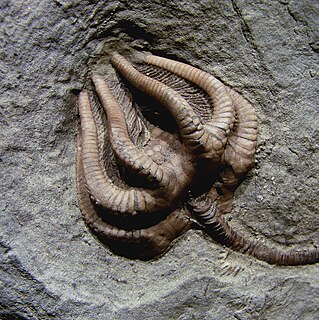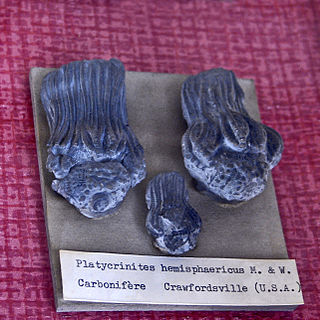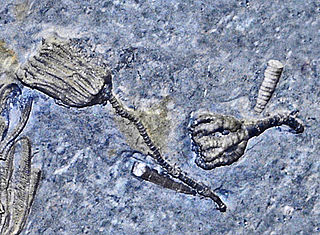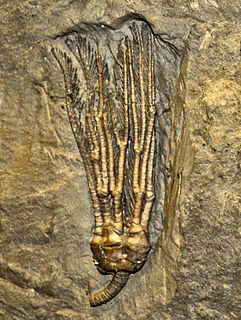| Scytalocrinus Temporal range: | |
|---|---|
 | |
| Fossil of Scytalocrinus from Carboniferous of the United States | |
| Scientific classification | |
| Kingdom: | |
| Phylum: | |
| Subphylum: | |
| Class: | |
| Subclass: | |
| Order: | |
| Family: | |
| Genus: | Scytalocrinus |
| Scytalocrinus Temporal range: | |
|---|---|
 | |
| Fossil of Scytalocrinus from Carboniferous of the United States | |
| Scientific classification | |
| Kingdom: | |
| Phylum: | |
| Subphylum: | |
| Class: | |
| Subclass: | |
| Order: | |
| Family: | |
| Genus: | Scytalocrinus |
This genus is known in the fossil records of the Carboniferous period of United States and United Kinhgdom (age range: from 345.3 to 314.6 million years ago). [2]

Crinoids are marine animals that make up the class Crinoidea, one of the classes of the phylum Echinodermata, which also includes the starfish, brittle stars, sea urchins and sea cucumbers. Those crinoids which, in their adult form, are attached to the sea bottom by a stalk are commonly called sea lilies, while the unstalked forms are called feather stars or comatulids, being members of the largest crinoid order, Comatulida.
Raymond Cecil Moore was an American geologist and paleontologist. He is known for his work on Paleozoic crinoids, bryozoans, and corals. Moore was a member of US Geological Survey from 1913 until 1949. In 1919 he became professor at the University of Kansas (Lawrence). In 1953 Professor Moore organized the launch and became the first editor of the still ongoing multi-volume work Treatise on Invertebrate Paleontology. Contributors to the Treatise have included the world's specialists in the field. He served as president of the Geological Society of America in 1958. In 1970 he was awarded the Mary Clark Thompson Medal from the National Academy of Sciences.

Platyceras is a genus of extinct Paleozoic sea snails, marine gastropod mollusks in the family Platyceratidae. This genus is known from the Silurian to the Middle Triassic periods and especially abundant in the Devonian and Carboniferous. It is the type genus of the family Platyceratidae.

Platyceratidae is an extinct family of Paleozoic sea snails, marine gastropod mollusks. This family may belong in the Patellogastropoda or the Neritimorpha.
Aglaocrinus is an extinct species of crinoids in the Cladia order. It has been proposed that it was a blind, stationary (attached) suspension feeder the hard parts of which were composed of magnesium calcite. It has been discovered in 3 locations in North America.

Agaricocrinus americanus, the mushroom crinoid, is a species of extinct crinoid, known only from its fossils, which are found in the U.S. states of Indiana, Tennessee and Kentucky. They date back to the Lower Mississippian, about 345 million years ago.

Bourgueticrinida is an order of crinoids that typically live deep in the ocean. Members of this order are attached to the seabed by a slender stalk and are known as sea lilies. While other groups of crinoids flourished during the Permian, bourgueticrinids along with other extant orders did not appear until the Triassic, following a mass extinction event in which nearly all crinoids died out.

The Camerata or camerate crinoids are an extinct subclass of Paleozoic stalked crinoids. They originated during the Early Ordovician, reached their maximum diversity during the Mississippian and became extinct during the Permian–Triassic extinction event.

Gilbertsocrinus are an extinct genus of Paleozoic stalked crinoids.

Agaricocrinus is a genus of extinct crinoids, belonging to the family Coelocrinidae.

Platycrinites are an extinct genus of Paleozoic stalked crinoids belonging to the family Platycrinitidae.
The Pitkin Formation, or Pitkin Limestone, is a fossiliferous geologic formation in northern Arkansas that dates to the Chesterian Series of the late Mississippian. This formation was first named the "Archimedes Limestone" by David Dale Owen in 1858, but was replaced in 1904. The Pitkin conformably overlies the Fayetteville Shale and unconformably underlies the Pennsylvanian-age Hale Formation. Some workers have considered the top of the Pitkin Formation to be a separate formation called the Imo Formation. However more recently, others have considered it as an informal member of the Pitkin Formation.

Forbesiocrinus is an extinct genus of crinoids.

Taxocrinus is an extinct genus of crinoids.

Abrotocrinus is an extinct genus of crinoids.

Ulrichicrinus is an extinct genus of crinoids.

Comatulidae is a family of comatulid crinoids. Since 2015, it replaces the family Comasteridae.
Lecythiocrinus is an extinct genus of sea lily belonging to the order Cyathocrinida and family Codiacrinidae. Species of this genus have been found in Pennsylvanian beds in Australia and North America.
Paragassizocrinus is an extinct genus of sea lily belonging to the family Agassizocrinidae.